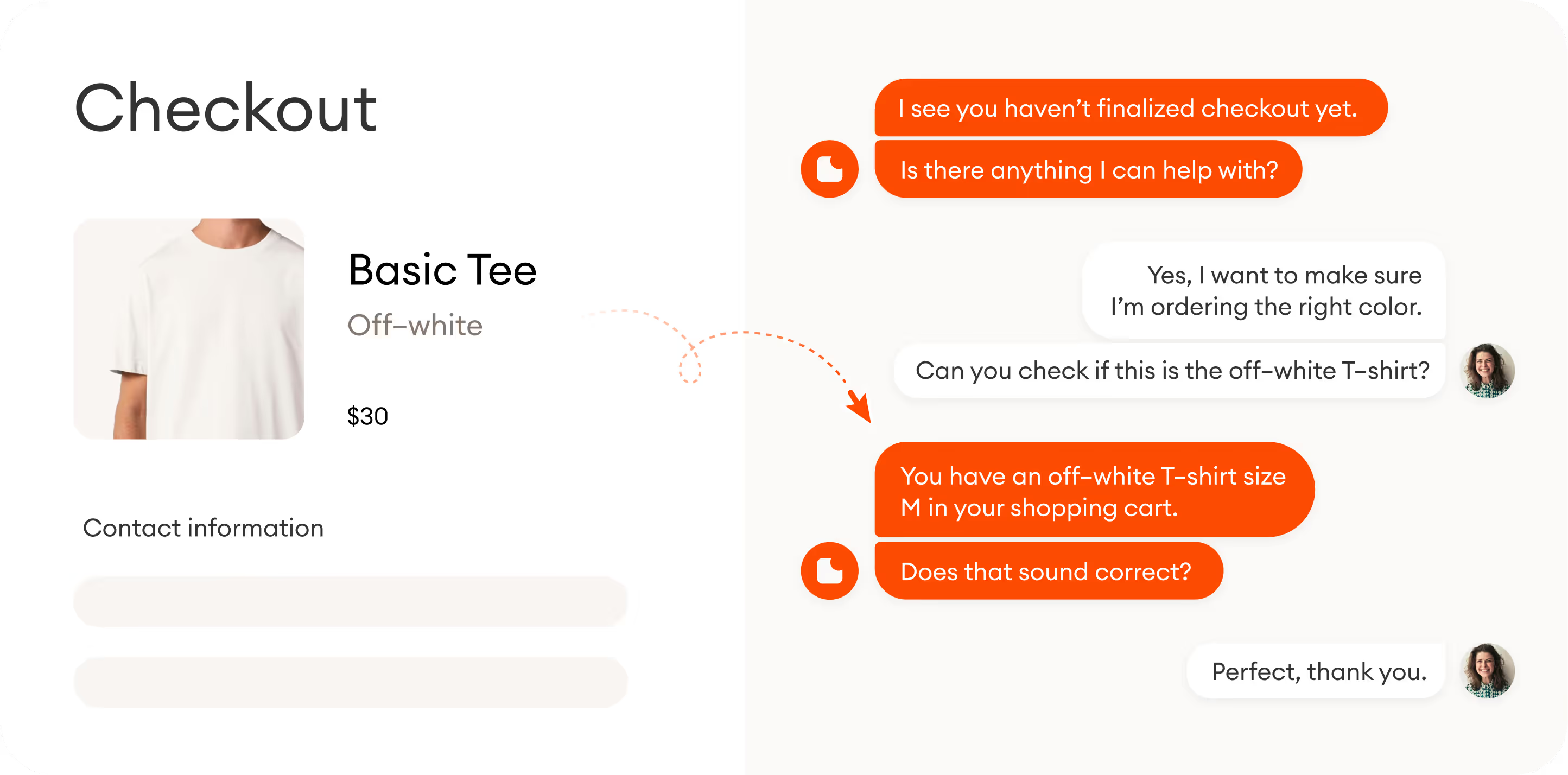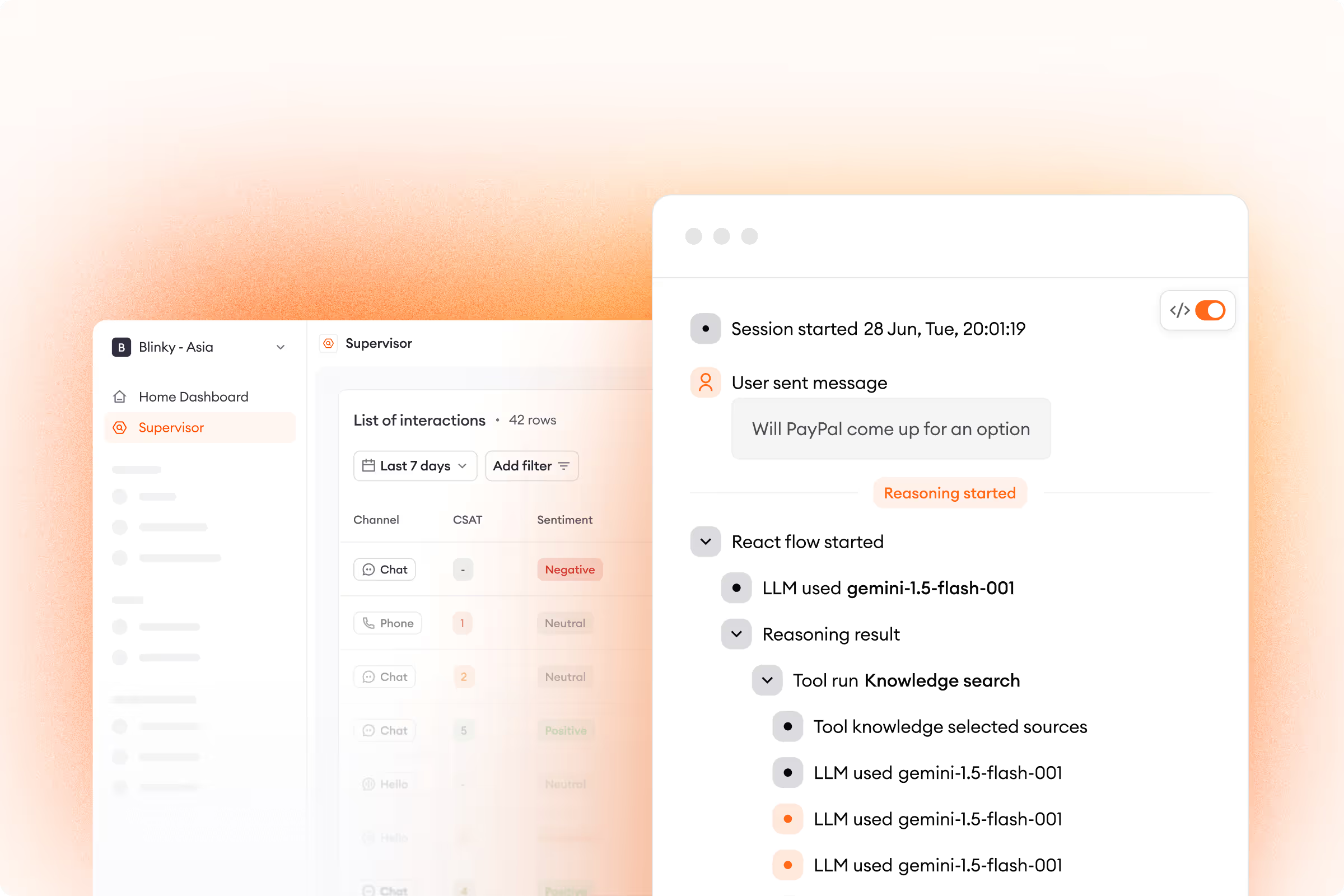The benefits of artificial intelligence (AI) in customer service couldn’t be clearer: customers are more satisfied, agents more efficient, and business resources optimized.
With everyone buzzing about AI, now’s the time to drown out the noise and find out how you can put this tech to good use before you risk falling behind.
But knowing precisely where to implement AI within your customer support infrastructure can be tricky. This blog post breaks it down for you and lays out the 9 best places to implement AI into your customer service.
9 places to add AI in customer service
1. Your homepage chatbot
An AI-powered chatbot is a simple yet powerful tool that provides immediate assistance to customers from the moment they visit your homepage. Shoppers have overwhelmingly gotten over the stigma of using this technology. For common queries, many actually prefer interacting with a chatbot instead of a customer support agent. In fact, 81% of online shoppers want a higher level of self-service than what’s currently available.

And with today’s cutting-edge machine learning tech, an AI chatbot is a surefire way to improve the user experience while freeing your customer service representatives to handle more complex customer issues. To start providing instant support, a chatbot only needs to access your FAQ page and convert the answers into a working knowledge base. With AI constantly working to boost automation potential, your chatbot will only become more effective over time.
2. Email
Email is one of the most popular customer support channels. More email tickets, however, place a greater burden on your support agents, highlighting how critical AI technology can be in enhancing your team’s email support.
AI can assist with email in a number of ways. For routine questions, AI software can send out automated replies to take care of any repetitive tasks. Using AI to filter and prioritize emails can also help your support team focus on their most important customer questions.
Advanced conversational AI tools can even recreate the chatbot experience over email, fully resolving common cases without human interaction. AI-enhanced email doesn’t just deliver instant assistance and increased agent efficiency, but it’s also capable of reducing your cost per ticket by 85%.
3. Ticket routing
Manually routing customer queries to the appropriate support agent can be time-consuming and complex. Not to mention, prioritizing tickets without a formula can lead to tickets being missed or pushed down the chain because it’s unclear who should answer them. This often leads to increased wait times, with customers having to repeat themselves and support reps spending more time transferring customers than actually helping them.
AI-powered ticket routing features ensure that queries get addressed promptly and efficiently. For example, a no-code workflow builder lets teams create complex automations with decision trees that lead customers to the answers they’re seeking.
Furthermore, AI solutions can detect a customer’s intent and automatically put shoppers in touch with the proper agent. Users looking for product details are routed to a product expert, those looking for shipping info are sent to an order specialist, and so on.
Pro tip: You don’t need separate AI solutions for automating chat and ticket routing. Zowie can serve as your all-in-one AI customer service platform capable of integrating with your existing tech stack.
4. Customer feedback
Another useful application of AI in customer service is for collecting customer feedback. Manually gathering feedback is often tedious. Worse still, analyzing said feedback and deciding on the best course of action can be challenging for the best support teams.
Not only does AI make collecting feedback easier, but it also helps ecommerce businesses identify the voice of the customer (VOC) to determine exactly which measures to take. Employ an AI tool to ask customers to rate and comment on each interaction. From there, the AI digs through all of your feedback data to provide actionable insights into what customers are finding most satisfying or frustrating.
Leveraging AI to help you to monitor quality assurance enables businesses to continuously improve their products, services, and overall customer experience.
5. Translations
Breaking into a new market might sound daunting to support teams who don't speak the same language as their customers. With AI-enabled translations, brands can reach customers across borders without a crash course on Duolingo.
AI software that’s fueled by natural language processing (NLP) allows teams to translate their entire knowledge base into multiple languages with a single click. When paired with an AI chatbot, companies can connect with any customer in their preferred language 24/7/365 — even changing languages mid-conversation when needed.
Additionally, NLP can provide insights into regional preferences and needs, enabling you to tailor your products and services to specific markets. Looking to identify and promote the top-performing items in each market? AI’s got you covered.

6. Checkout
Using AI at the start of the customer journey is important, but leveraging it to guide shoppers at various touchpoints all the way through to checkout is equally vital. In the form of proactive chats, conversational AI can help at checkout in several ways.
First, AI solutions can detect whenever a customer appears stuck and automatically launch proactive assistance, answering questions about products, shipping, or the checkout process as a whole.

Moreover, proactive customer messages can also be launched to increase the average order value (AOV) by informing shoppers about free shipping thresholds or exclusive promotions they may qualify for.

Learn more about proactive customer service and the benefits it brings ecommerce brands in our Proactive vs Reactive Customer Service blog post.
7. Support-driven sales
Having AI at checkout doesn’t just improve the customer experience — it leads to substantial sales. AI customer service chatbots, for one, are able to boost sales by 67%.
Backing customer service agents with AI places your product catalog, pricing info, and shipping details right at your reps’ fingertips, helping them to provide faster and more accurate solutions.
On top of this, AI offers human agents access to stores of customer data. Before typing a single response, reps instantly see a shopper’s past purchases, mood, and intent, so they’re able to provide personalized customer interactions and product recommendations that are most likely to get shoppers to convert.
Pro tip: AI in customer service is just as helpful at preventing cart abandonment. Whenever a shopper leaves your page for another tab, AI can deliver and ping and a flash via your website’s tab to bring their focus back to their shopping cart.
8. Social media
According to Hubspot, 84% of businesses expect social media to become shoppers’ preferred customer service channel by the end of this year.
And failing to provide top-notch support over social media can have serious consequences. Nearly half of all customers unfollow a brand if it can’t provide timely support over social, and over a third share their negative experiences with their social circle.
As support teams must attend to more customer tickets and higher demands over Messenger, Instagram, and other social networks, embracing AI will be essential. AI chatbots can be just as effective on social media as they are on business websites. Today’s top tools link up seamlessly with the major social platforms to ensure customers’ needs are met on every support channel.
9. Support metrics dashboard
Giving your agents real-time support metrics can help them see just how effectively they’re performing and where there’s still room for improvement. Infusing AI into your metrics allows you to track key categories, such as first response time, automation rate, and CSAT scores.
What makes this information so crucial? Your team will be able to set clearer KPIs and measure goals more accurately. Strategic decision-making is simplified as you’re able to explore what’s working best and refine workflows wherever needed.
AI where you want it
Incorporating AI into your customer service strategy can revolutionize your business by improving efficiency, driving growth, and increasing customer satisfaction.
To stay on top of the latest developments on all things related to AI in customer service, visit Zowie’s AI Knowledge Center, our comprehensive resource base for brands looking to maximize efficiency and unlock their revenue-generating potential.
.avif)







